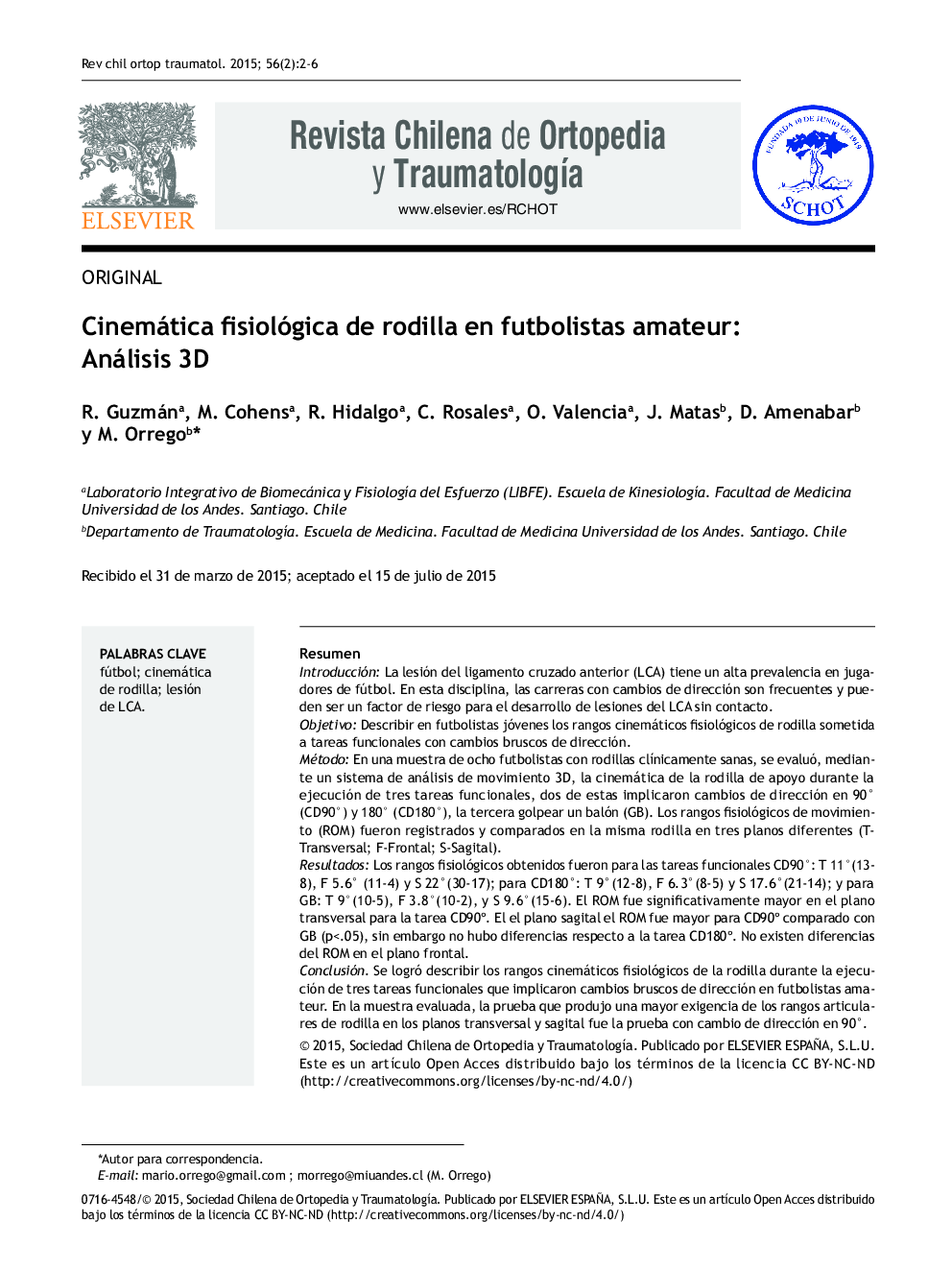| کد مقاله | کد نشریه | سال انتشار | مقاله انگلیسی | نسخه تمام متن |
|---|---|---|---|---|
| 4086011 | 1267918 | 2015 | 5 صفحه PDF | دانلود رایگان |

ResumenIntroducciónLa lesión del ligamento cruzado anterior (LCA) tiene un alta prevalencia en jugadores de fútbol. En esta disciplina, las carreras con cambios de dirección son frecuentes y pueden ser un factor de riesgo para el desarrollo de lesiones del LCA sin contacto.ObjetivoDescribir en futbolistas jóvenes los rangos cinemáticos fisiológicos de rodilla sometida a tareas funcionales con cambios bruscos de dirección.MétodoEn una muestra de ocho futbolistas con rodillas clínicamente sanas, se evaluó, mediante un sistema de análisis de movimiento 3D, la cinemática de la rodilla de apoyo durante la ejecución de tres tareas funcionales, dos de estas implicaron cambios de dirección en 90° (CD90°) y 180° (CD180°), la tercera golpear un balón (GB). Los rangos fisiológicos de movimiento (ROM) fueron registrados y comparados en la misma rodilla en tres planos diferentes (T-Transversal; F-Frontal; S-Sagital).ResultadosLos rangos fisiológicos obtenidos fueron para las tareas funcionales CD90°: T 11°(13-8), F 5.6° (11-4) y S 22°(30-17); para CD180°: T 9°(12-8), F 6.3°(8-5) y S 17.6°(21-14); y para GB: T 9°(10-5), F 3.8°(10-2), y S 9.6°(15-6). El ROM fue significativamente mayor en el plano transversal para la tarea CD90°. El el plano sagital el ROM fue mayor para CD90° comparado con GB (p<.05), sin embargo no hubo diferencias respecto a la tarea CD180°. No existen diferencias del ROM en el plano frontal.Conclusión.Se logró describir los rangos cinemáticos fisiológicos de la rodilla durante la ejecución de tres tareas funcionales que implicaron cambios bruscos de dirección en futbolistas amateur. En la muestra evaluada, la prueba que produjo una mayor exigencia de los rangos articulares de rodilla en los planos transversal y sagital fue la prueba con cambio de dirección en 90°.
IntroductionAnterior cruciate ligament (ACL) lesions are frequent among soccer players. In this sport cutting movements are usually made while running and may be a risk factor in developing non-contact ACL injuries.PurposeTo describe the physiological kinematics of the knee during sudden change of direction movements in amateur soccer players.MethodsEight amateur soccer players without previous injuries were analysed. The kinematics of the support knee were evaluated using 3D motion analysis while executing 3 common manoeuvres: two of them involved a change of direction at 90° and 180° (CD90° and CD180°), and the third while kicking a ball (GB). Physiological articular ranges of motion (ROM) were recorded and compared for the same knee in three different planes (T-Transversal; F-Frontal; S-Sagittal).ResultsThe physiological ranges obtained were, for manouvre CD90°: T 11°(13-8), F 5.6° (11-4) and S 22°(30-17); for CD180°: T 9°(12-8), F 6.3°(8-5) and S 17.6°(21-14); and for GB: T 9°(10-5), F 3.8°(10-2), and S 9.6°(15-6). ROM was significantly greater in the transversal plane for the CD90° manoeuvre (P<.05). In the sagittal plane, ROM was greater for the CD90° when compared to the GB (P<.05), but no differences were seen when compared to the CD180° manoeuvre (P>.05). There were no differences in ROM in the frontal plane.ConclusionA description of the physiological kinematic ranges of the knee during three sudden changes of direction manoeuvres in amateur soccer players was presented. According to our results, change of direction in 90° demands a higher range of motion in both the transversal and sagittal planes.
Journal: Revista Chilena de Ortopedia y Traumatología - Volume 56, Issue 2, May–August 2015, Pages 2–6